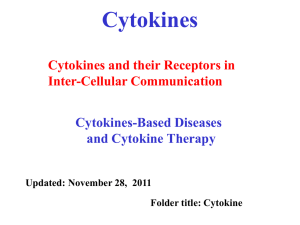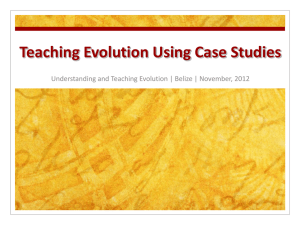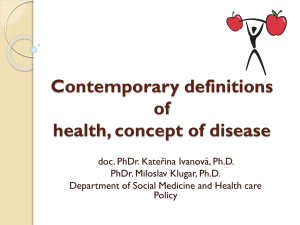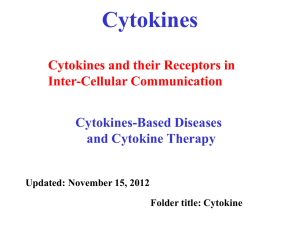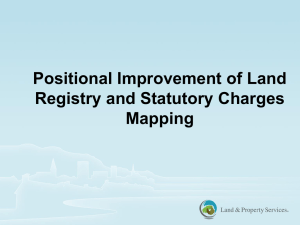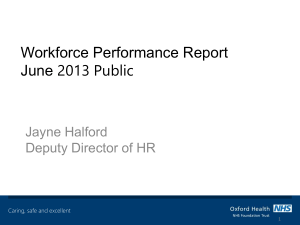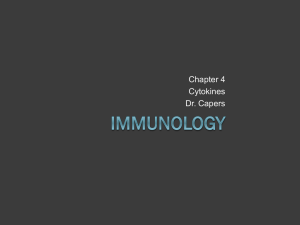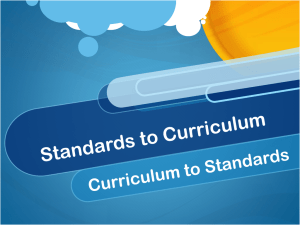LPS
advertisement
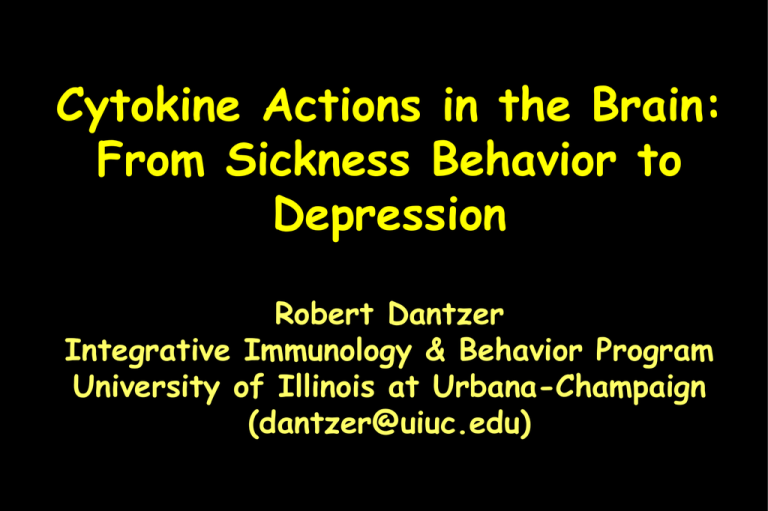
Cytokine Actions in the Brain: From Sickness Behavior to Depression Robert Dantzer Integrative Immunology & Behavior Program University of Illinois at Urbana-Champaign (dantzer@uiuc.edu) The Golden Age of Psychoneuroimmunology in the 1970s: Immune Responses are Modulated by Brain Events What is processed by the brain has an impact on the functioning of the immune system (e.g., psychosocial events, emotions…). This is possible because the immune system is connected to the brain via autonomic nerves and neuroendocrine factors and shares common cellular communication messengers. CNS STRESSORS Neuroendocrine factors ANS Immune cells An Emerging Concept in the late 1980s: The Immune System Needs to Talk to the Brain Like any other physiological system in the body, the immune system needs the brain to do what it has to do and to be regulated If it is the case, the brain has an « immunostat » that enables it to perceive and represent what is going on in the immune system, using immune cell communication molecules (cytokines) CNS ANS & Neuroendocrine Factors Cytokines Immune cells Pathogen-associated molecular patterns (PAMPs) Innate immune cells (TLRs) NFkB Proinflammatory cytokines Interleukin-1b Peripheral immune response - non-specific - specific CNS response - fever - HPA axis activation - sickness behavior - malaise SICKNESS BEHAVIOR NT CRH/AVP ACTH + Adrenal cortex Cortisol Efferent vagus - Proinflammatory cytokines (IL-1, TNFa, IL-6) Innate immune cells - PAMPs The syndrome of just being sick In 1925, Hans Selye who was then a second year medical student at Prague noted that irrespective of their disease all patients “felt and looked ill, had a coated tongue, complained of more or less diffuse aches and pains in joints, and of intestinal disturbances associated with loss of appetite”. They also generally “had fever, enlarged spleen or liver, inflamed tonsils, and a number of other general symptoms.” He called this condition the syndrome of just being sick. 1.What are the mechanisms of action of cytokines on the brain? 2. How is organized the sickness response to cytokines? 3. How does sickness behavior translate into pathology? The sickness inducing effects of peripheral IL-1 are mediated centrally (from Kent et al, 1992) IL-1b IL-1ra How can peripherally produced cytokines act in the brain? PAMPs Peripheral cytokines Brain targets HPA axis activation Fever Sickness behavior Peripheral cytokines do not need to get into the brain because they are produced in the brain PAMPs Humoral pathway Peripheral cytokines Brain cytokines Neural pathway PGE2 Brain targets HPA axis activation Fever Sickness behaviour Visualization of IL-1 Receptors via NFkB Activation in the Rat Brain (Nadjar et al., 2003-2005) IL-1b ir NFkB ir AP 1-2 h BV NTS 2-4 h IL-1b Vagotomy abrogates the induction of hypothalamic IL-1b expression and sickness behavior LPS/ IL-1 Hypothalamic expression of IL-1b Social exploration VGX Sham From Layé, Bluthe et al, 1995 Conclusions By their actions on the brain, proinflammatory cytokines produced by activated macrophages and monocytes induce sickness behavior The brain forms a molecular and cellular representation of the peripheral immune response This representation is mediated by several immune-to-brain communication pathways including a neural pathway that is critical for sickness behavior 1. Why do we feel and behave in a sick way when we are ill? 2.How is organized the sickness response to cytokines? 3. How does sickness behavior translate into pathology? The behavioral effects of cytokines correspond to a reorganization of the host’s priorities (Aubert et al., 1997) Medical interpretation Internal state (weakness) Cytokines Behavioral alterations Motivational interpretation Cytokines Internal state Environmental contingencies LPS 24°C 24°C Behavioral alterations LPS 6°C MOTIVATIONAL INTERPRETATION OF FEAR Threat Fear Fear feelings Fear behavior Visceral arousal MOTIVATIONAL INTERPRETATION OF SICKNESS Threat Fear Fear feelings Fear behavior Visceral arousal Pathogenic microorganisms Sickness Malaise Sickness behavior Visceral arousal The brain forms a representation of the peripheral innate immune response. This representation is at the origin of sickness behavior Sickness behavior corresponds to a reorganization of the host’s priorities. Sickness behavior is normally fully reversible Georges Canguilhem: « être en bonne santé, c’est pouvoir tomber malade et s’en relever » (To be healthy is to be able to become ill and recover from it…) 1. Why do we feel and behave in a sick way when we are ill? 2. How is organized the sickness response to cytokines? 3.How does sickness behavior translate into pathology? Pathogen-associated molecular patterns Endogenous danger signals Peripheral proinflammatory cytokines Anti-inflammatory cytokines Cortisol Brain proinflammatory cytokines AVP a-MSH Non specific symptoms of disease Anorexia Anhedonia Cachexia Pain Cognitive disorders Mood disorders Fatigue What does happen when the innate immune system remains activated? Examples : - Chronic inflammatory disorders - Chronic administration of exogenous cytokines - Cancer - Aging - Viral pathologies Each of these conditions is associated not specific signs of the disease but also specific symptoms of an exaggerated response such as fatigue and an increased of affective and cognitive disorders. only with with non sickness incidence Prevalence of Depression in Patients with Immune-based Disorders Condition Prevalence General Population Cancer Autoimmune Disorders Cardiovascular Disease Chronic illnesses (e.g. irritable bowel syndrome, chronic fatigue syndrome) Obesity / Metabolic Syndrome See for review, Evans et al., Biological Psychiatry, 58, 2005 5-10% 18-39% 15-40% 15-40% 15-60% 20-30% Symptom Intensity Temporal Evolution of the Behavioral Symptoms Induced by Chronic Cytokine Therapy Neurovegetative Symptoms (e.g., fatigue) Mood and Cognitive Symptoms Sickness Behavior Depression Minimally responsive to antidepressants W 1-4 responsive to antidepressants W 4-8 Time on IFN-Alpha W 8-12 Initial MADRS Scores Predict Depressive Symptoms Four Weeks Later MADRS Score (D26) 35 R=0.753 p<0.001 30 25 20 IL-2 15 IL-2+IFN 10 Iv IFN 5 Y=1,53X+4,25 p<0,001 0 0 2 4 6 8 10 12 MADRS Score (D0) Capuron et al., NEJM,1999; 340: 1370 Pituitary-adrenal response to IFNa predicts the occurrence of depressive symptoms ACTH 800 Cortisol 700 *** 600 30 *** * 25 *** 400 300 ** 100 * ** 20 15 10 ** 200 CORT (g/dl) pg/ml 500 * *** 35 # 5 0 0 0h 1h 2h 3h IFN Depressed patients (n=8) Non- depressed patients (n=8) 0h 1h 2h 3h IFN Capuron et al., Am J Psychiat, 2003. Depressed mood is specifically associated with decreased plasma tryptophan levels in IFNa-treated patients Tryptophan Non-depr MDD MADRS score 30 R=-0.50 p<0.05 25 20 Symptom dimensions 15 Depression Anxiety Cognitive Neurovegetative Somatic 10 5 0 -60 -40 -20 0 TRP 20 40 rTRP -0.627* -0.674** -0.636** -0.381 -0.220 ** p<0.01 Capuron et al., 2002, 2003 Immune stimuli activate a key enzyme in the metabolism of tryptophan Food Proteins Tryptophan 5-HTP Kynurenine 5-HT IDO IFNg PAMPs Quinolinic acid Alterated glutamatergic neurotransmission Decreased serotoninergic neurotransmission IDO = indoleamine 2,3 dioxygenase BLOCKADE OF PROINFLAMMATORY CYTOKINE EXPRESSION BY Forced Swim Test FST Immobility (s) MINOCYCLINE ABROGATES LPS-INDUCED DEPRESSIVE-LIKE BEHAVIOR ** 160 120 80 40 Sal Mino ** TST Immobility (s) Tail Suspension Test Sal LPS 300 200 100 Sal Mino 0 Sal LPS BLOCKADE OF IDO BY 1-METHYL-TRYPTOPHAN ABROGATES FST Immobility (s) LPS-INDUCED DEPRESSIVE-LIKE BEHAVIOR * 160 120 Saline 80 LPS 40 Placebo 1-MT TST Immobility (s) * 300 200 100 Placebo 1-MT 0 Saline LPS Proinflammatory cytokines 0 .4 0 .3 0 .2 0 .1 LPS Age B IL-6 (ng/ml) 24 Proinflammatory cytokines 40 30 20 10 6 – – 6 m 24 m * 12 LPS Age 50 6 m 24 m 18 * 60 0 – – 80 * 60 40 20 0 0 Anti-inflammatory cytokines 70 0 .0 Anti-inflammatory cytokines Aging * IL-10 (ng/ml) 0 .5 IL-10 (ng/ml) Adult age A IL-6 (ng/ml) Aging is associated with chronic brain inflammation + + 6 m 24 m + + 6 m 24 m Figure 7. Secretion of IL-6 and IL-10 by glia from adult and aged mice in the absence (A) or presence (B) of 20 ng/mL of LPS. Bars represent the mean ± SEM. *P<.05. (Johnson et al., 2003) and this chronic brain inflammation has functional consequences… 20 20 20 00 0 20 -20 -20 40 -40 -40 60 -60 * -60 * * 80 ** -80 -80 * 100 -100 -100** ** * * 22 44 2 4 Duration of Immobility (sec) Adult CON CON Aged Aged CON CON Adult AdultLPS CON Aged AgedLPS CON Adult Adult LPS Aged LPS Adult LPS Aged LPS Forced swim test A. 180 24 h b ** * 140 120 *, ‡‡ *, *,‡ 88 8 24 24 24 Hours Post Injection Hours HoursPost PostInjection Injection (Godbout et al.) a 100 80 60 a 40 20 Adu lt Adu lt Ag ed Ag ed Salin e L P S Salin e L P S . 140 B. *, ‡‡ *, *,‡ b 160 0 Duration of Immobility (sec) baseline) (% Behavior Social baseline) (% Behavior Social Social Behavior (% baseline) Social exploration 72 h 120 a 100 80 b a a 60 40 20 0 Adu lt Adu lt Ag ed Ag ed Salin e L P S Salin e L P S The brain forms a molecular and cellular representation of the activation state of the innate immune system. This representation organizes the normal response of the host to infection and danger signals. This representation can lead to the development of disorders of affect and cognition. These processes are amplified in situation of chronic inflammation including aging & obesity. Neuroimmune interactions represent new targets for health promoting compounds. Chronic peripheral inflammation Risk factors for inflammatory disorders Activation of brain cytokine signaling Risk factors for psychiatric disorders Subjective health complaints: - Fatigue, Pain - Sleep disorders - Depressed mood - Cognitive alterations INVESTIGATIONS IN NEURO-IMMUNE PROGRAMMING Neonatal activation of the immune system (Variation factors: time, nature of the stimulus} Alterations in BW regulation adiposity, fever, HPA axis activity and reactivity Neural development Anxiety Neurodevelopmental hypothesis of autism and schizophrenia


